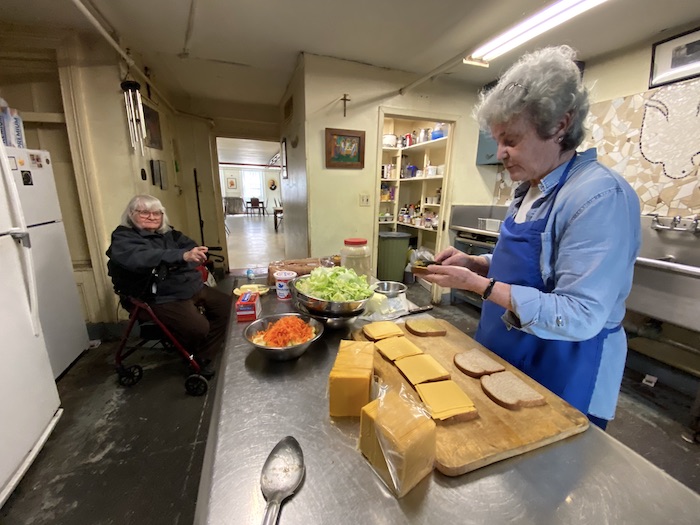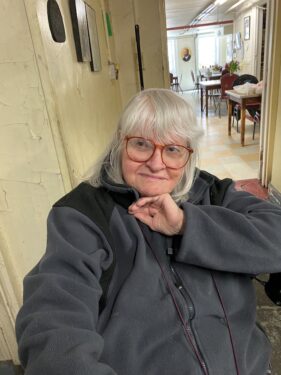
THE BOWERY — As lunch is prepared at the Catholic Worker hospitality house on East 3rd Street, the kitchen releases an aroma of savory lentil soup, served with thick chunks of freshly baked cornbread. Classical music plays in the background.
When it’s served, hungry women of all ages and ethnicities file in and take their seats for the meal.
Jane Sammon, a Cleveland native, has lived and worked at the hospitality house, commonly known as “Maryhouse,” since 1972. She greets most everyone, longtime visitors and newcomers, by name.
The women appear to be dealing with homelessness, mental illness, or poverty — or all three. But the details of their circumstances are largely unknown to the volunteers. They don’t ask.
This hospitality house — like its counterpart for men nearby on East 1st Street, and an estimated 80 more in the U.S. and abroad — is in the business of providing corporal and spiritual works of mercy as described in Matthew 25:35-46.
The Catholic Worker Movement has been doing this work for 90 years. It was formed on May 1, 1933, in New York City by French poet Peter Maurin and Brooklyn-born journalist and social activist Dorothy Day (1897-1980), who is under consideration for sainthood.
Sammon is the only remaining “worker” at Maryhouse who knew Day, learned from her, and served as her “aide-de-camp.”
“Now, I wasn’t here in ’33, but I would say that we do what the Catholic Church is already known for — trying to perform the corporal works of mercy, to feed the hungry, clothe the naked, etc.
“What we do now is what we did then.”
Maryhouse was a music school until Day bought it in 1975 and converted it into a hospitality center. She died there in 1980.
It is not fancy. The walls could use paint, but the kitchen is clean. Hanging on a wall is a portrait of Mother Cabrini, with a holy card depicting the devotion to the Divine Mercy tucked into the frame. There are also lots of pictures of Day.

During lunch, some of the women visit with others amiably. One of them recites a litany of grievances against government institutions and street thugs. Her voice lowers to a whisper as her accusations become more serious until only her lips move.
Another woman seems agitated as she moves her chair around a table until she discovers her preferred angle. Later, Sammon says she has known the woman for several years.
“She’s not been doing well lately,” Sammon says. “She’s very troubled and she’s very intellectually gifted. If you could see her at her best, she’s fabulous. She sleeps on the street and various places. I don’t know the whole picture of what happened.
“We don’t really know, unless someone wants to share their life with you in that way. We don’t put pressure on women to tell us their life stories.”
A young woman, however, cheerfully introduces herself — Keishia McQuilkin — who, according to Sammon, “is a good egg.”
McQuilkin describes how Maryhouse offers a daytime break from life in the homeless shelter system. She says she’d like to one day run her own nonprofit to help the homeless.
“The shelter system is not always safe,” she says. “Your stuff gets stolen and it’s hard to get a good night’s sleep.”
Maryhouse, she says, “is safe. People know about it, and Jane is especially trustworthy. Here you can get a meal and some clothes. It makes a difference. You experience the peace of heaven.”
The Catholic Worker Movement began early in the Great Depression on the streets of the Lower East Side, where entrenched poverty had already saddled droves of immigrants for nearly a century.
A newspaper, The Catholic Worker, was the impetus for the movement. Through the writings of Day, Maurin, and others, it promoted human dignity, acts of mercy, but also hard work — earning wages to meet one’s most basic needs, forsaking wealth, and pursuing “voluntary poverty” instead.
The Catholic Worker is still published, and still only costs a penny per issue.
“Communities” like the hospitality houses evolved as vehicles for the Catholic workers to practice what they preached. Other communities based on Day’s teachings run farms or shops.
Intellectualism is matched with manual labor in the communities. Maryhouse, for example, hosts Friday night roundtable discussions for participants to hash out the weighty issues of the day — social, economic, and spiritual.
If one is inclined to say this is a bunch of liberal-progressive claptrap, Sammon assures the movement has heard such criticisms since it began.
As Day championed Church doctrine on caring for the poor, she also promoted pacifism and the equal distribution of wealth. But she rejected any form of communism that included atheism.
The movement has its own “manifesto,” but according to Sammon, that word leads some people to think of the “Communist Manifesto” of Karl Marx.
“We’re not communists,” she says. “We’re Catholic Workers.”
She says the Sermon on the Mount (Matthew 5-7 — where Jesus preached the Beatitudes) “is our manifesto.”
The hospitality house exists solely through contributions from supporters. The workers do not apply for grants or accept government funding.
“It’s through the grace of God and the generosity of our contributors,” Sammon says. “But there’s no guarantee because we don’t put our money into interest-bearing accounts or anything like that. It’s in and it’s out.
“When we have it, thank God for that, but we’ve had our times when we were pretty lean.”
